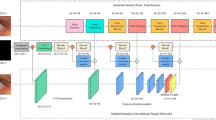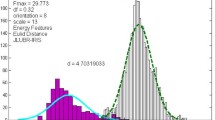Abstract
Iris images collected under different conditions often suffer from specular reflections, cast shadows, motion blur, defocus blur, occlusion caused by eyelashes and eyelids, eyeglasses, hair and other artifacts. Existing iris recognition systems do not perform well on these types of images. To overcome these problems, an iris recognition method based on relative total variation (RTV) and probabilistic collaborative representation is proposed. RTV uses the l1 norm regularization method to robustly suppress noisy pixels to achieve accurate iris localization, while probability collaborative representation maximizes the probability that the test sample belongs to each of the multiple classes. The final recognition rate is calculated based on the class having maximum probability. Experimental results using CASIA-V4-Lamp and IIT-Delhi V1iris image databases showed that the proposed method achieved competitive performance in both recognition accuracy and computational efficiency.







Similar content being viewed by others
References
Ahamed A, Bhuiyan MIH (2012) Low complexity iris recognition using curvelet transform. In: 2012 international conference on informatics. Electronics & Vision (ICIEV), IEEE, pp 548–553
Alliney S (1997) A property of the minimum vectors of a regularizing functional defined by means of the absolute norm. IEEE Trans Signal Process 45(4):913–917
Al-Raisi A, Al-Khouri A (2008) Iris recognition and the challenge of homeland and border control security in UAE. Telematics Inform 25(2):117–132
Barpanda SS, Sa PK, Marques O, Majhi B, Bakshi S (2018) Iris recognition with tunable filter bank based feature. Multimed Tools Appl 77(6):7637–7674
Belcher C, Du Y (2009) Region-based SIFT approach to iris recognition. Opt Lasers Eng 47(1):139–147
Bhateja AK, Sharma S, Chaudhury S, Agrawal N (2016) Iris recognition based on sparse representation and k-nearest subspace with genetic algorithm. Pattern Recogn Lett 73:13–18
Bowyer KW, Hollingsworth K, Flynn PJ (2008) Image understanding for iris biometrics: a survey. Computer Vision & Image Understanding 110(2):281–307
Cai S, Zhang L, Zuo W, Feng X (2016). A probabilistic collaborative representation based approach for pattern classification. In: Proceedings of the IEEE conference on computer vision and pattern recognition, 2950–2959
CASIA Iris Database. http://www.cbsr.ia.ac.cn/english/Databases. 5 May 2013
Chen C-H, Chu C-T (2009) High performance iris recognition based on 1-D circular feature extraction and PSO–PNN classifier. Expert Syst Appl 36(7):10351–10356
Daugman JG (1993) High confidence visual recognition of persons by a test of statistical independence. IEEE Transactions on Pattern Analysis & Machine Intelligence 15(11):1148–1161
Daugman J (2006) Probing the uniqueness and randomness of IrisCodes: results from 200 billion iris pair comparisons. Proc IEEE 94(11):1927–1935
Davies E (2012). Circle and ellipse detection. Computer and Machine Vision, Fourth Edition: Theory, Algorithms, Practicalities
Farouk R (2011) Iris recognition based on elastic graph matching and Gabor wavelets. Comput Vis Image Underst 115(8):1239–1244
Gangwar A, Joshi A (2016). DeepIrisNet: deep iris representation with applications in iris recognition and cross-sensor iris recognition. In: 2016 IEEE international conference on image processing (ICIP), IEEE, 2301-2305
Haghighat M, Zonouz S, Abdel-Mottaleb M (2015) CloudID: trustworthy cloud-based and cross-enterprise biometric identification. Expert Syst Appl 42(21):7905–7916
Hajari K, Gawande U, Golhar Y (2016) Neural network approach to iris recognition in noisy environment. Procedia Computer Science 78:675–682
He F, Han Y, Wang H, Ji J, Liu Y, Ma Z (2017) Deep learning architecture for iris recognition based on optimal Gabor filters and deep belief network. Journal of Electronic Imaging 26(2):023005
Hua J, Wang H, Ren M, Huang H (2017) Collaborative representation analysis methods for feature extraction, neural comp. Appl. 28(S1):225–231
IIT Delhi Iris Database version 1.0. http://web.iitd.ac.in/~biometrics/Database_Iris.htm
Jain AK, Ross A, Prabhakar S (2004) An introduction to biometric recognition. IEEE Transactions on Circuits & Systems for Video Technology 14(1):4–20
Jan F, Usman I, Agha S (2012) Iris localization in frontal eye images for less constrained iris recognition systems. Digital Signal Processing 22(6):971–986
Jeong DS, Hwang JW, Kang BJ, Park KR, Won CS, Park D-K, Kim J (2010) A new iris segmentation method for non-ideal iris images. Image Vis Comput 28(2):254–260
Karn P, He X, Yang S, Wu X (2014) Iris recognition based on robust principal component analysis. Journal of Electronic Imaging 23(6):063002
Kaur B, Singh S, Kumar J (2018) Robust iris recognition using moment invariants. Wirel Pers Commun 99(2):799–828
Khalighi S, Pak F, Tirdad P, Nunes U (2015) Iris recognition using robust localization and nonsubsampled contourlet based features. Journal of Signal Processing Systems 81(1):111–128
Kumar A, Chan T-S (2012). Iris recognition using quaternionic sparse orientation code (QSOC). In: 2012 IEEE computer society conference on computer vision and pattern recognition workshops, IEEE, 59–64
Labati RD, Scotti F (2010) Noisy iris segmentation with boundary regularization and reflections removal. Image Vis Comput 28(2):270–277
Leng L, Zhang J, Chen G, Khan MK, Alghathbar K (2011). Two-directional two-dimensional random projection and its variations for face and palmprint recognition. In: international conference on computational science and its applications,458-470, springer, Berlin, Heidelberg
Li P, Liu X, Xiao L, Song Q (2010) Robust and accurate iris segmentation in very noisy iris images. Image Vis Comput 28(2):246–253
Liu C, Wechsler H (2002) Gabor feature based classification using the enhanced fisher linear discriminant model for face recognition. IEEE transactions on image Processing 11(4):467–476
Majumdar A, Ward RK (2010) Robust classifiers for data reduced via random projections. IEEE trans. Syst. Man Cyb. Part B (Cyb.) 40(5):1359–1371
Masek L, Kovesi P (2003). MATLAB source code for a biometric identification system based on iris patterns. School of Computer Science and Software Engineering, University of Western Australia. http://www.csse.uwa.edu.au/~pk/studentprojects/libor/sourcecode.html
Meshgini S, Aghagolzadeh A, Seyedarabi H (2013) Face recognition using Gabor-based direct linear discriminant analysis and support vector machine. Comput Electr Eng 39(3):727–745
Minaee S, Abdolrashidiy A, Wang Y (2016). An experimental study of deep convolutional features for iris recognition. In: 2016 IEEE signal processing in medicine and biology symposium (SPMB), IEEE, 1-6
Monro DM, Rakshit S, Zhang DX (2007) DCT-based Iris recognition. IEEE Trans Pattern Anal Mach Intell 29(4):586–595
Petrovska D, Mayoue A (2007). Description and documentation of the biosecure software library, project no IST-2002-507634 -BioSecure, Deliverable
Pillai JK, Patel VM, Chellappa R, Ratha NK (2011) Secure and robust iris recognition using random projections and sparse representations. IEEE Trans Pattern Anal Mach Intell 33(9):1877–1893
Poursaberi A, Araabi BN (2006) Iris recognition for partially occluded images: methodology and sensitivity analysis. EURASIP Journal on Advances in Signal Processing 2007:1–12
Rahulkar AD, Holambe RS (2012) Half-iris feature extraction and recognition using a new class of biorthogonal triplet half-band filter bank and flexible k-out-of-n: a postclassifier. IEEE Transactions on Information Forensics and Security 7(1):230–240
Rai H, Yadav A (2014) Iris recognition using combined support vector machine and hamming distance approach. Expert Syst Appl 41(2):588–593
Raja KB, Raghavendra R, Venkatesh S, Busch C (2017) Multi-patch deep sparse histograms for iris recognition in visible spectrum using collaborative subspace for robust verification. Pattern Recogn Lett 91:27–36
Ross A, Jain AK 2004 multimodal biometrics: an overview. In: European Signal Processing Conference
Roy K, Bhattacharya P, Suen CY (2011) Towards nonideal iris recognition based on level set method, genetic algorithms and adaptive asymmetrical SVMs. Eng Appl Artif Intell 24(3):458–475
Shen L, Bai L, Fairhurst M (2007) Gabor wavelets and general discriminant analysis for face identification and verification. Image Vis Comput 25:553–563
Si Y, Mei J, Gao H (2012) Novel approaches to improve robustness, accuracy and rapidity of Iris recognition systems. IEEE Transactions on Industrial Informatics 8(1):110–117
Song Y, Cao W, He Z (2014) Robust iris recognition using sparse error correction model and discriminative dictionary learning. Neurocomputing 137:198–204
Tsai C-C, Lin H-Y, Taur J, Tao C-W (2011) Iris recognition using possibilistic fuzzy matching on local features. IEEE Transactions on Systems, Man, and Cybernetics, Part B (Cybernetics) 42(1):150–162
Viriri S, Tapamo J (2017) Iris pattern recognition based on cumulative sums and majority vote methods. Int J Adv Robot Syst 14(3):1729881417703931
Wang N, Li Q, El-Latif AAA, Zhang T, Niu X (2014) Toward accurate localization and high recognition performance for noisy iris images. Multimed Tools Appl 71(3):1411–1430
Wildes RP (1997) Iris recognition: an emerging biometrie technology. Proc IEEE 85(9):1348–1363
Wright J, Yang AY, Ganesh A, Sastry SS, Ma Y (2009) Robust face recognition via sparse representation. IEEE Trans Pattern Anal Mach Intell 31(2):210–227
Xiao F, Huang K, Qiu Y, Shen H (2018). Accurate iris center localization method using facial landmark, snakuscule, circle fitting and binary connected component. Multimedia Tools and Applications:1–21
Xu L, Yan Q, Xia Y, Jia J (2012) Structure extraction from texture via relative total variation. ACM Transactions on Graphics (TOG) 31(6):139
Zhang L, Yang M, Feng X (2011). Sparse representation or collaborative representation: which helps face recognition? In: Proceedings of the IEEE conference on computer vision, 471–478
Zhao Z, Ajay K (2015). An accurate iris segmentation framework under relaxed imaging constraints using total variation model. In: Proceedings of the IEEE International Conference on Computer Vision, 3828–3836
Zhao Z, Kumar A (2017). Towards more accurate iris recognition using deeply learned spatially corresponding features. In: Proceedings of the IEEE International Conference on Computer Vision, 3809–3818
Acknowledgments
The authors thank the anonymous reviewers for their thorough and valuable comments and suggestions. This work was supported by the National Natural Science Foundation of China (NSFC) Grant No. 61871279, the Industrial Cluster Collaborative Innovation Project of Chengdu Grant No. 2016-XT00-00015-GX, the Sichuan Science and Technology Program Grant No. 2018HH0143 and the Sichuan Education Department Program Grant No. 18ZB0355.
Author information
Authors and Affiliations
Corresponding author
Additional information
Publisher’s note
Springer Nature remains neutral with regard to jurisdictional claims in published maps and institutional affiliations.
Rights and permissions
About this article
Cite this article
Karn, P., He, X., Zhang, J. et al. An experimental study of relative total variation and probabilistic collaborative representation for iris recognition. Multimed Tools Appl 79, 31783–31801 (2020). https://doi.org/10.1007/s11042-020-09553-7
Received:
Revised:
Accepted:
Published:
Issue Date:
DOI: https://doi.org/10.1007/s11042-020-09553-7




